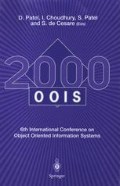Abstract
This paper presents the theoretical background to Janus, an ongoing project that has been more fully described elsewhere, that explores the use of software patterns organised in a pattern language, to capture and express the normally tacit and configurational knowledge that is the essence of architectural knowledge. Software development, considered as a professional practice is a design discipline which has been, historically, poorly served by the positivist traditions of Computer Science. Architectural knowledge, as understood in the context of other professional disciplines in which it is utilised, drives design at all levels of scale. The creation of software architectures requires some way of expressing this normally tacit knowledge. The experiences, first of ADAPTOR and now of Janus, strongly suggest that pattern languages may provide just such a vehicle.
Access this chapter
Tax calculation will be finalised at checkout
Purchases are for personal use only
Preview
Unable to display preview. Download preview PDF.
References
Alexander, C. 1964. Notes on the Synthesis of Form. New York: Oxford University Press
Alexander C., S. Ishikawa, and M. Silverstein with M. Jacobson, I. Fiksdahl-King and S.Angel 1977. A Pattern Language: Towns, Buildings, Construction. New York: Oxford University Press
Alexander, C. 1979. The Timeless Way of Building. New York: Oxford University Press
Barnard C. 1938. The Functioning of the Executive. Cambridge, Mass: Cambridge University Press
Bass, L. P. Clements and R. Kazman. 1998. Software Architecture in Practice. Reading, Mass: Addison Wesley
Bernstein R.J. 1976. The Restructuring of Social and Political Theory. New York: Harcourt Brace Jovanovich
Blum B.I. 1996. Beyond Programming: To a New Era of Design. New York: Oxford University Press
Blum B.I. 1998. Software Engineering: A Holistic Approach. New York: Oxford University Press
Borenstein. N.S. 1991. Programming as if People Mattered: Friendly Programs, Software Engineering, and Other Noble Delusions. Princeton, N.J: Princeton University Press
Buschmann F., C. Jäkel, R. Meunier, H. Rohnert and M. Stahl 1996. Pattern-Oriented Software Architecture: A System of Patterns. Chichester, England: John Wiley
Coplien J.O. 1995. “A Generative Development-Process Pattern Language” in J.O. Coplien and D.C. Schmidt (eds.) Pattern Languages of Program Design. Reading, MA: Addison Wesley
Duffy F. and L Hutton 1998. Architectural Knowledge: the Idea of a Profession, London: E. and F.N. Spon.
Gamma E., R. Helm, R. Johnson and J. Vlissides.1995. Design Patterns. Reading, MA: Addison Wesley
Graham, I. 1998. Requirements Engineering and Rapid Development. London, Eng: Addison Wesley
Hillier, B. 1996.Space is the Machine. Cambridge, Eng: Cambridge University Press
Jackson M.1995. Software Requirements and Specifications: A Lexicon of Practice, Principles and Prejudices. Harlow, Essex: Addison Wesley
O’Callaghan A. ADAPTOR: A Pattern Language for the Re-engineering of Systems to Object Technology. IEE Colloquium on Software Engineering. May 1998.
O’Callaghan A. 1999. Migrating Large-Scale Legacy Systems to Component-based and Object Technology: The Evolution of a Pattern Language. Communications of the AIS. 2(3) July, http://cais.isworld.org/
O’Callaghan A. with R.W. Farmer and P. Dai. 1999. Patterns for Change. Proceedings of EuroPlop 1999. Irsee, Germany.
O’Callaghan A. 2000. Patterns for an Architectural Praxis. Proceedings of EuroPlop 2000. Irsee, Germany.
Polyani M. 1967. The Tacit Dimension. New York: Doubleday
Schon D.A. 1983. The Reflective Practitioner. New York: Basic Books
Selic B., G. Gullekson, P.T. Ward, B. Selic and J McGee. 1994. Real-time Object-Oriented Modeling. New York: John Wiley & Sons.
Shaw M.1990. Prospects for an Engineering Discipline of Software. IEEE Software 7 (6): pp. 15–24. November.
Shaw M., R. DeLine, D. V. Klein, T.L. Ross, D.M. Young, and G. Zelesnik.1995. Abstractions for Software Architecture and Tools to Support Them. IEEE Transactions on Software Engineering. 21 (4): 314–315. April.
Shaw M. and D. Garlan 1996. Software Architecture: Perspectives on an Emerging Discipline. Reading, Mass: Addison Wesley
Stowell, F.A. and D. West. 1994. Client-led Design: A Systemic Approach to Information System Development. London: McGraw Hill.
Author information
Authors and Affiliations
Editor information
Editors and Affiliations
Rights and permissions
Copyright information
© 2001 Springer-Verlag London Limited
About this paper
Cite this paper
O’Callaghan, A. (2001). Janus: Using a Pattern Language to Create Software Architecture. In: Patel, D., Choudhury, I., Patel, S., de Cesare, S. (eds) OOIS 2000. Springer, London. https://doi.org/10.1007/978-1-4471-0299-1_28
Download citation
DOI: https://doi.org/10.1007/978-1-4471-0299-1_28
Publisher Name: Springer, London
Print ISBN: 978-1-85233-420-8
Online ISBN: 978-1-4471-0299-1
eBook Packages: Springer Book Archive

